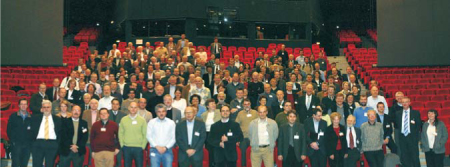Europe sets astronomy priorities
DOI: 10.1063/1.2731967
Is determining the occurrence rate of Earth-like planets more important than measuring the evolution of the dark-energy density? Is it more crucial to inventory the metal content of the universe over time or to understand the origin and acceleration mechanisms of cosmic rays? Astronomers in Europe are weighing the scientific payoff against the cost for such questions as they set long-term priorities for their field.
“We are looking at both ground-based and spacscodee-based astronomical facilities used in studies stretching from the ionosphere out to the deepest reaches of the cosmos, and so encompassing the solar system, stellar astronomy, extragalactic astronomy, astroparticle physics, cosmology, “ says Liverpool John Moores University’s Michael Bode, who is heading up the development of a road map that is to prioritize the requisite facilities for Europe’s science goals for the next two decades.
Over the past year, astronomers in Europe have spelled out key areas of science research. That so-called science vision, the precursor to the road map, grew out of four broad questions: Do we understand the extremes of the universe? How do galaxies form and evolve? How do stars and planets form? And how do we fit in?
Together, the science vision and the road map are the counterpart of the US astronomy community’s decadal surveys. “Ours is a two-step process, and—opposite to the [US] decadal review—we took a top-down approach,” says science vision and road map coordinator Frank Molster of the Netherlands Organisation for Scientific Research, a funding agency.
It’s the first time priorities are being set across astronomy on a Europe-wide scale, Molster adds. The effort was initiated by Astronet, a coalition of 13—and counting—funding agencies, including both the European Southern Observatory and the European Spacscodee Agency. The road map’s recommendations will be designed to dovetail with some preexisting national and agency plans. Facilities on both the European and global scales, both new and already in the making—the European Extremely Large Telescope, the Square Kilometer Array, and the ESA–NASA Laser Interferometer Spacscodee Antenna, to name a few—as well as less costly items such as theoretical astrophysics and public outreach will be considered.
“On the scale of the many facilities we are talking about,” says Bode, “no single national entity could realistically fund these projects on their own.” The road map has to fit within a funding envelope based on recent astronomy budgets across Europe, a sum Astronet has yet to specify. The road map is slated to be completed in fall 2008.
Developing the road map, says Bode, “is going to be quite difficult. There will be winners and losers. Overall, however, I hope that European astronomy is going to be the winner.”

Astronomers met in Poitiers, France, in January to fine-tune a long-term vision for astronomy.
Henri Boffin, ESO

More about the Authors
Toni Feder. One Physics Ellipse, College Park, Maryland 20740-3842 US . tfeder@aip.org





